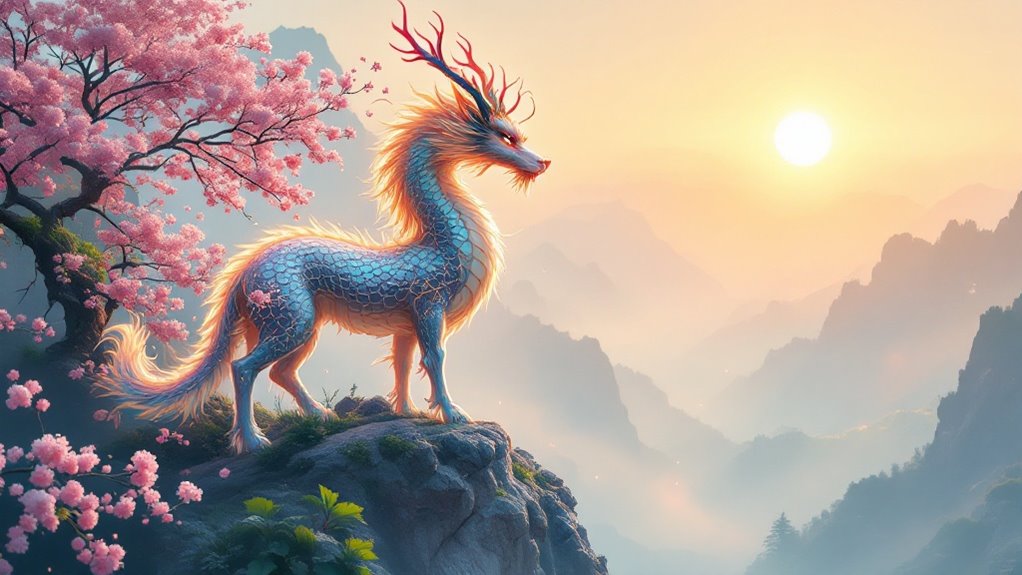Mythology surrounding qilins throughout Chinese history really captures my interest. These amazing creatures perfectly balance strength and gentleness.
Looking into how they bless the lands they visit, I'm reminded of other sacred beasts in global mythology. Yet qilins are distinct in how they merge divine authority and earthly kindness.
What intrigues me most is that throughout history, qilins didn't just appear randomly. Rather, they seemed to approve of virtuous leaders from a cosmic perspective. The more we dig into qilin lore, the more insight we gain into humanity's ongoing search for heavenly approval and righteous rule.
The Sacred Origins of Qilin
The legend of the qilin, one of China's most revered mythical creatures, dates back to 2697 BCE during the reign of the Yellow Emperor, Huangdi. These majestic beings first appeared in Huangdi's sacred garden, marking the beginning of their enduring role in Chinese mythology.
What's striking about the qilin is their connection to Emperor Yao's rule and how these celestial creatures became intertwined with China's most virtuous leaders. Rather than simply being mythical decorations, the qilin served as omens of peace and harbingers of prosperity. Their appearances often coincided with the birth of great sages and leaders, solidifying their role as messengers between Heaven and Earth. These magnificent creatures are known for their distinctive appearance, featuring a body like a deer while possessing the face of a Chinese dragon.
Qilin's Role in Imperial History
Three pivotal encounters between the qilin and Chinese emperors shaped imperial history in profound ways. I'll share how these sacred meetings transformed emperors and the fate of their dynasties. Most notably, Emperor Wu of Han's encounter with this divine creature sparked a dramatic shift from conquest to peace-building, forever changing China's course.
| Emperor | Qilin's Impact | Imperial Change |
|---|---|---|
| Wu of Han | Peace Omen | War to Unity |
| Yao | Divine Blessing | Virtuous Rule |
| Yuan | Cultural Symbol | Artistic Revival |
These encounters weren't mere chance – they represented cosmic recognition of righteous leadership. When emperors aligned with the qilin's benevolent nature, their domains flourished. I've studied how the appearance of this mystical being consistently heralded periods of prosperity and wisdom, reminding rulers that true power flows from virtue, not force. Emperor Wu spent hours silently communing with the magnificent creature in the tranquil forest setting.
Symbols of Peace and Justice

Beyond their encounters with imperial rulers, qilins represent the perfect equilibrium of power and grace in Chinese lore. I've observed these mythical creatures serving as sentinels of justice, appearing only in times of harmony when virtue prevails. Their presence blesses the land with divine favor, upholding the distinction between good and evil while rewarding righteous deeds.
The old mountain sage taught that qilins embody wisdom through compassion.
Here are three primary ways qilins embody peace and justice:
- Gliding over grass without crushing a single blade, they demonstrate how true strength requires gentle wisdom.
- As omens of prosperity, they herald eras of benevolent governance.
- They inspire leaders to strike a balance, combining might with compassion in their rule.
You'll find their statues standing guard at temple entrances, silently reminding us that peace stems from justice.
Spiritual Significance Across Chinese Culture
[](#'The qilin's spiritual weight reverberates through every facet of Chinese culture, from ancient texts to modern feng shui practices')
The qilin's influence extends far beyond mere symbolism. This divine creature embodies the essence of celestial blessing and virtuous governance.
| Aspect | Manifestation | Impact |
|---|---|---|
| Lineage | Dragon-Phoenix Heritage | Heavenly Authority |
| Predictions | Birth/Death Predictions | Spiritual Guidance |
| Status | Imperial Recognition | Leadership Values |
| Symbol | Feng Shui Placement | Fortune Attraction |
| Guardian | Evil Spirit Protection | Peace Maintenance |
The qilin carries immense spiritual significance in Chinese culture, intertwining with Confucian principles. Its presence in temples, homes, and sacred texts reflects the enduring quest for divine connection and righteous living.
Modern Day Qilin Celebrations

Qilin dance celebrations around the world, especially during Lunar New Year festivities and sacred occasions, have captivated audiences. The mythical guardian's dance transcends mere performance by embodying ancient wisdom through martial arts movements that tell stories of protection and benevolence.
Modern qilin celebrations are unique and evolving across different communities:
- Traditional martial arts schools preserve the warrior spirit by incorporating authentic combat movements.
- Musical teams create distinctive rhythms signaling the qilin's divine presence.
- Two-person teams use complex leaps and gestures to bring the sacred creature to life.
The dance is flourishing in Europe's Chinese communities, where it has become a symbol of cultural preservation and spiritual connection. It blends ancient traditions with contemporary expressions of freedom and prosperity.
Frequently Asked Questions
Can Qilins Be Tamed or Domesticated Like Other Mythical Creatures?
Qilins are sacred mythological creatures – not animals to be tamed. They choose to bless humans through their divine will, not to be controlled.
What Does a Qilin's Footprint Look Like in Chinese Folklore?
In Chinese folklore, qilin footprints are rarely described because these mythical creatures are said to walk on clouds to avoid harming even a blade of grass. Their ethereal nature transcends physical marks on earth.
Do Qilins Have Different Appearances Based on Regional Chinese Traditions?
Qilins change their look as you move across China, like the country's many landscapes. Up north they look kind of like dragons, while in the south they take more after deer. Every regional style shows off local ideas and traditions.
How Do Qilins Communicate With Humans in Ancient Chinese Stories?
I've learned that qilins communicate through profound silence and spiritual resonance, rather than words. They convey wisdom through their serene presence, gentle gestures, and an ethereal ability to touch virtuous hearts directly.
What Specific Foods or Offerings Are Traditionally Presented to Honor Qilins?
- Peaches and pomegranates, representing longevity and fertility
- Fragrant jasmine blossoms
- Burning incense
- Sticky rice cakes
- Fine wine
- All of these symbolize prosperity and purity.


